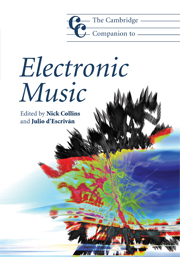Book contents
- Frontmatter
- Introduction
- Part I Electronic music in context
- Part II Electronic music in practice
- 5 Interactivity and live computer music
- 6 Algorithmic composition
- 7 Live audiovisuals
- 8 Network music
- 9 Electronic music and the moving image
- 10 Musical robots and listening machines
- Part III Analysis and synthesis
- Notes
- References
- Index
9 - Electronic music and the moving image
from Part II - Electronic music in practice
Published online by Cambridge University Press: 28 September 2011
- Frontmatter
- Introduction
- Part I Electronic music in context
- Part II Electronic music in practice
- 5 Interactivity and live computer music
- 6 Algorithmic composition
- 7 Live audiovisuals
- 8 Network music
- 9 Electronic music and the moving image
- 10 Musical robots and listening machines
- Part III Analysis and synthesis
- Notes
- References
- Index
Summary
In the composer, [Tarkovsky] sought not the author of music, but the organiser of audio space of the film . . .
e. artemievWashington, Virginia, USA, 1951; the Washington Obelisk; Lincoln Memorial. A strange low pulsing sound fills the air; it has a bell-like quality. You think you recognise the swelling of a tam-tam roll, but there is also a strange low pulsing sound which does not seem to match anything you have ever heard before. As you see a bright gigantic white disc overfly the Capitol, you recognise the familiar sound of some kind of aircraft. People stop and stare at the skies. A high-pitched bleep is heard momentarily as the disc flies overhead. Now both the pulse and the flying roar seem to modulate together varying in speed and timbral colour. People run and scream as the object prepares to land and the sound becomes more intense: a strong wind, static electricity, a motor sound; all fuse in and out of a pitch-bending tonal hum. The sound of a short servomechanism punctuates the landing. It has arrived!
Within The Day The Earth Stood Still (1951), the real and the imaginary become one through the magic of the soundtrack. As the film progresses, the leading musical themes are played by two Theremins. Thanks to their unfamiliarity to the listener, their characteristic gliding sound endows the music of the film with an otherworldly quality by visual association with UFO imagery. The soundtrack of the film contains, then, two main musical elements: the organisation of processed sounds to represent the noises of extraterrestrial elements and atmospheric moods, and the use of electronic instrumentation to imbue the orchestral film score with a futuristic sheen.
- Type
- Chapter
- Information
- The Cambridge Companion to Electronic Music , pp. 156 - 170Publisher: Cambridge University PressPrint publication year: 2007
- 3
- Cited by

